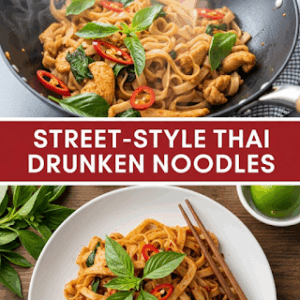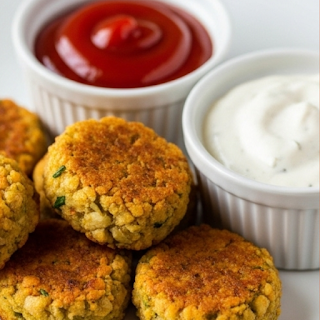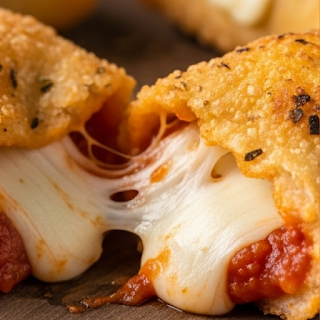If you’re craving bold flavors, vibrant colors, and that irresistible balance of spicy, savory, and slightly sweet, then Thai Drunken Noodles—also known as Pad Kee Mao—are the perfect recipe to satisfy your taste buds. This famous Thai street food dish is made with wide rice noodles stir-fried in a flavorful sauce, combined with protein, fresh vegetables, and plenty of fragrant Thai basil. The result is a quick yet impressive meal that feels like it came straight from your favorite takeout spot.
The dish is known for its fiery heat and rich flavor profile, thanks to the combination of garlic, chilies, soy sauce, and oyster sauce. The chewy rice noodles soak up every drop of sauce, while crunchy vegetables add freshness and texture. Protein options like chicken, beef, tofu, or shrimp make it customizable for any diet. And of course, the star ingredient is Thai holy basil, which gives the noodles their signature aromatic punch.

Despite its restaurant-quality taste, Drunken Noodles are surprisingly easy to make at home. In less than 30 minutes, you can prepare this dish using simple pantry staples with a few special ingredients like fish sauce or Thai basil. It’s the ideal option for busy weeknights when you want something quick, hearty, and full of authentic Thai flavors. Whether you serve it spicy or mild, this recipe delivers that satisfying mix of comfort food and exotic street-style flair in every bite.
Benefits of Thai Drunken Noodles
Beyond their bold taste, Thai Drunken Noodles offer many benefits that make them a fantastic addition to your meal rotation. From nutritional advantages to lifestyle convenience, here’s why they’re worth making:
1. Quick to Prepare: With a prep-and-cook time of under 30 minutes, this dish is perfect for weeknight dinners or last-minute cravings.
2. Versatile Proteins: You can use chicken, beef, shrimp, or tofu depending on your preference. Each option blends beautifully with the sauce and noodles.
3. Nutrient Boost: The addition of vegetables like bell peppers, onions, or Chinese broccoli provides fiber, vitamins, and antioxidants. Thai basil adds not only fragrance but also antibacterial properties.
4. Customizable Spice Levels: Traditional drunken noodles are spicy, but you can easily adjust the heat by reducing or increasing the amount of chilies.
5. Balanced Flavors: The dish delivers the perfect mix of savory, sweet, and spicy, stimulating the palate and leaving you completely satisfied.
6. Restaurant-Quality at Home: Save money and calories by making this street food favorite in your own kitchen. You can control the ingredients and adjust them to your dietary needs.
7. Comfort Meets Nutrition: The chewy rice noodles are comforting, while the fresh vegetables and lean protein keep the dish light and energizing.
Thai Drunken Noodles are more than just a quick stir-fry—they’re a flavor-packed, customizable, and wholesome dish that proves you can enjoy authentic Thai cuisine without leaving your home.
Nutritional Information
A bowl of Thai Drunken Noodles (Pad Kee Mao) is satisfying yet surprisingly balanced when prepared at home. Wide rice noodles provide quick energy from complex carbohydrates, while your chosen protein—chicken, shrimp, beef, tofu, or tempeh—adds staying power. The dish is cooked fast over high heat, so vegetables retain their crunch and vitamins. Thai basil, garlic, ginger, and chilies layer flavor without relying on heavy fats.
Estimated values per serving (1/4 of recipe, chicken version, without optional fried egg):
- Calories: 460–520 kcal
- Protein: 24–30 g
- Carbohydrates: 60–68 g
- Fat: 12–16 g
- Fiber: 3–5 g
- Sodium: moderate to high (reduce with low-sodium soy and less fish sauce)
What makes it wholesome? Rice noodles are naturally gluten-free; lean proteins bolster satiety; and veg such as bell pepper, onion, long beans, or Chinese broccoli add vitamin C, K, and antioxidants. Using a neutral oil with a high smoke point keeps the stir-fry light, while a splash of oyster/soy/fish sauces gives depth with small amounts. To lighten further, use less oil, swap half the noodles with spiralized zucchini or cabbage ribbons, and add a handful of bean sprouts at the end. For athletes or meal-prep, add a fried or poached egg on top to bump protein by 6–7 g. For lower sodium, rely more on aromatics (garlic, basil, chili) and a squeeze of lime at the end to brighten flavor without extra sauce.
Creative Variations
Pad Kee Mao is famous for being flexible. Use these ideas to tailor heat, texture, and nutrition while keeping the dish’s street-style character.
1) Protein Play: Swap chicken for shrimp (fast-cooking and sweet), thin-sliced flank steak (extra-umami), tofu/tempeh (press first for crisp edges), or a mixed mushroom trio for a meatless version.
2) Spice Control: Traditional versions are fiery. Reduce bird’s-eye chilies for mild heat or add chili paste, chili oil, or crushed red pepper for extra kick. A drizzle of hot honey gives sweet-spicy depth.
3) Veggie Boost: Add broccoli florets, snow peas, bok choy, carrots, baby corn, or kale. Stir-fry sturdy veg first, delicate leaves last.
4) Lighter & Gluten-Free: Use tamari or coconut aminos instead of regular soy sauce; choose gluten-free oyster sauce or a quick hoisin substitute if needed. Replace part of the noodles with shredded cabbage to cut calories and add crunch.
5) Basil Options: Holy basil (preferred) brings peppery aroma. If unavailable, mix sweet basil with a pinch of black pepper and a few mint leaves for brightness.
6) Street-Style Extras: Finish with a squeeze of lime, a fried egg, and roasted peanuts. Serve with cucumber slices to cool the heat.
7) One-Pan Meal Prep: Double the sauce, cook proteins/veg in batches to keep wok heat high, then toss everything quickly with soaked noodles. Portion into containers; reheat with a splash of water to loosen.
Ingredients Table
Quantities below serve 4. Adjust chilies and sauces to taste. If using shrimp or beef, same amounts apply.
| Ingredient | Quantity | Notes |
|---|---|---|
| Wide rice noodles (fresh or dried) | 400 g fresh or 250 g dried | Soak dried noodles till pliable; don’t overcook |
| Chicken breast or thighs (or tofu) | 500 g (1.1 lb), thinly sliced | Marinate briefly with 1 tsp soy + 1 tsp cornstarch (optional) |
| Neutral oil (canola/peanut) | 2–3 tbsp | High smoke point for wok cooking |
| Garlic, minced | 4–5 cloves | Key aromatic; stir-fry 10–15 sec |
| Fresh red Thai chilies | 2–4, sliced | Adjust for heat; sub chili flakes |
| Onion or shallots | 1 medium, sliced | Sweet balance and crunch |
| Bell pepper / Chinese broccoli | 2 cups total | Any mix of crisp vegetables |
| Thai holy basil (or sweet basil) | 1 packed cup leaves | Add off heat to preserve aroma |
| Sauce – soy sauce (or tamari) | 3 tbsp | Use low-sodium if preferred |
| Sauce – oyster sauce | 2 tbsp | For glossy umami; GF versions available |
| Sauce – fish sauce | 1–1½ tbsp | Salty depth; reduce for lower sodium |
| Sauce – dark soy (optional) | 1 tsp | Adds color and slight sweetness |
| Sauce – sugar or palm sugar | 1–2 tsp | Balances heat and saltiness |
| Lime wedges & roasted peanuts | For serving | Classic finish; adds brightness and crunch |
| Fried egg (optional) | 1 per serving | Street-food style protein boost |
Tip: Keep the wok screaming hot and cook in small batches to avoid steaming. Toss fast, add basil at the end, and serve immediately while the noodles are glossy and aromatic.
Step-by-Step Instructions
- Prep the noodles: If using dried wide rice noodles, soak in hot water for 20–25 minutes until pliable but not mushy. Drain and set aside. If using fresh noodles, separate strands and keep covered to prevent drying.
- Make the sauce: In a small bowl, whisk together soy sauce, oyster sauce, fish sauce, dark soy (if using), sugar, and a splash of water or broth. Taste and adjust for balance of salty, sweet, and savory.
- Cook the protein: Heat 1 tbsp oil in a hot wok or skillet. Add chicken (or chosen protein) and stir-fry 3–4 minutes until browned and just cooked through. Remove and set aside.
- Aromatics: Add remaining oil to the wok. Stir-fry garlic and chilies for 15–20 seconds until fragrant—avoid burning.
- Add vegetables: Toss in onion and bell pepper (or Chinese broccoli). Stir-fry 2–3 minutes until crisp-tender.
- Combine noodles & sauce: Add soaked noodles and cooked protein back to the wok. Pour in the prepared sauce. Toss vigorously over high heat for 2–3 minutes until noodles are evenly coated and glossy.
- Finish with basil: Remove from heat, fold in Thai holy basil, and let it wilt into the noodles. Serve immediately.
Serving Suggestions
- Classic Style: Serve hot straight from the wok with lime wedges and crushed peanuts on the side.
- Street Food Style: Top each portion with a fried egg for extra richness and protein.
- Healthier Option: Pair with a cucumber salad or steamed bok choy to cool the heat.
- Meal Prep: Store portions in airtight containers. Reheat with a splash of water in a hot skillet to loosen the sauce.
- Custom Heat: Offer chili flakes, chili oil, or sriracha at the table for spice lovers.
Conclusion
Thai Drunken Noodles (Pad Kee Mao) capture the heart of Thai street food—spicy, bold, and incredibly satisfying. With chewy rice noodles, savory sauce, and the punch of Thai basil, every bite is bursting with flavor. This recipe is quick enough for weeknights, customizable for any diet, and impressive enough to serve guests.
Whether you enjoy it fiery with bird’s-eye chilies or keep it mild, this dish brings authentic Thai flair to your kitchen in under 30 minutes. It’s comfort food with an exotic twist, making it a recipe you’ll return to again and again.



